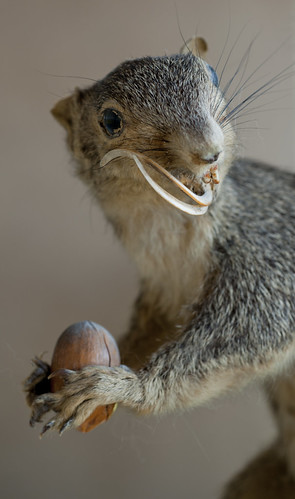This fox squirrel had a nasty case of malocclusion when it died. Many species of mammals, including humans, can develop malocclusion, but it's the most dramatic with rodents: rodent incisors grow constantly, meaning they must gnaw constantly to wear down their teeth. When a squirrel has a cleft palate or a broken jaw (or is fed an improper diet its entire life), the incisors no longer align properly, resulting in overgrown, curled teeth.
In some extreme cases, the top incisors can grow so long that they pierce through the palate, and may continue back out the top of the animal's head. It's a miserable existence, and most rodents with malocclusion don't live for very long – pain and infections aside, it's hard to eat, and many die of starvation. One has to wonder if the taxidermist who mounted this squirrel – holding a nut it obviously could never eat – had a bit of a sick sense of humor.
This mount may have ended up in a dumpster, so I'm very happy to instead have it in my collection. It's bizarre, sad, and a wonderful example of how torturous Mother Nature can be.







Nicely written. Thanks for sharing.
ReplyDeleteVery nice.
DeleteIf you plan to sell let me know.
ReplyDelete